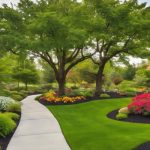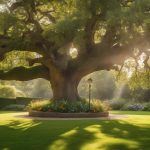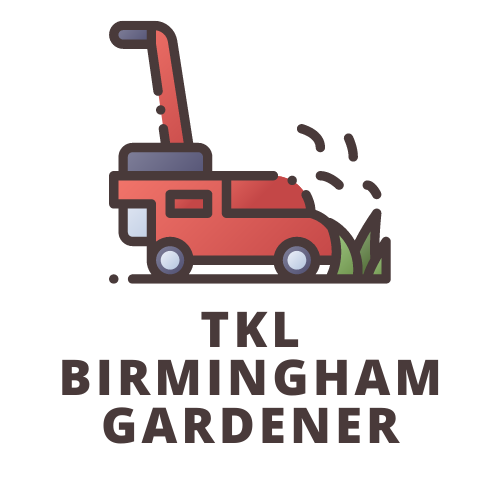
Top Tree Care Consultations for Landscaping Success
8 October 2024
3 Best Services for Mature Tree Care
8 October 2024The three best tree care consultations for landscaping projects focus on tree health assessments, species suitability, and planting techniques.
A thorough health assessment identifies stress, disease, or pest issues, while evaluating soil quality determines the best tree species for your environment.
Selecting the right species ensures compatibility with soil and climate conditions, promoting long-term growth and aesthetic appeal.
Moreover, effective planting techniques lay the foundation for robust trees that enhance property value.
Engaging experts in these consultations can significantly improve landscape success, guiding you through each critical phase of tree care.
Discover more insights into optimising your landscaping efforts.
Tree Health Assessment Essentials
Contents
A thorough tree health assessment begins with effective visual inspection techniques, enabling professionals to identify signs of stress, disease, or pest infestations.
Moreover, evaluating soil quality is essential, as it directly impacts tree vigour and growth potential.
Together, these methods form the foundation for informed decision-making in landscaping projects.
Visual Inspection Techniques
How can one effectively gauge the health of a tree during a visual inspection? A thorough examination begins at the base of the tree, evaluating the root zone for signs of decay or pest activity.
Progressing upwards, inspect the trunk for wounds, cracks, or bark abnormalities that may indicate stress or disease.
The canopy deserves equal attention; examine the foliage for discolouration, wilting, or premature leaf drop, which may signal nutrient deficiencies or environmental stressors.
Furthermore, observe the branch structure for signs of dieback or abnormal growth patterns.
Documenting these findings systematically allows for a detailed understanding of the tree's health.
Ultimately, a keen, trained eye during visual inspections serves as an essential tool in effective tree care and management strategies.
Soil Quality Evaluation
Evaluating soil quality is a fundamental aspect of assessing tree health, as it directly influences the tree's growth and resilience. A thorough analysis encompasses several parameters, including pH, nutrient content, texture, and moisture retention.
Soil pH affects nutrient availability, while a balanced nutrient profile—rich in nitrogen, phosphorus, and potassium—is essential for optimal tree vitality. Soil texture determines drainage and aeration, impacting root development and overall health.
Moreover, evaluating organic matter content is critical, as it improves soil structure and fosters beneficial microbial activity. Employing soil testing methods, such as laboratory analysis or field kits, provides actionable insights for amending soil deficiencies.
Tree Species Suitability
Selecting the appropriate tree species for landscaping projects requires careful consideration of several key factors.
Soil type compatibility, pest resistance evaluation, and growth rate are critical elements that influence not only the health of the trees but also the overall success of the landscaping design.
A thorough analysis of these aspects will ensure that the chosen species thrive in their intended environment.
Soil Type Compatibility
Understanding soil type compatibility is essential for ensuring the successful growth and longevity of tree species in landscaping projects.
Different tree species thrive in specific soil conditions, which can significantly impact their health and performance.

Request a free quote!
Consider the following aspects when evaluating soil type compatibility:
- Soil Texture: Sandy soils provide excellent drainage but may lack nutrients, whereas clay soils retain moisture but can impede root growth.
- pH Levels: Acidic, neutral, or alkaline conditions can influence nutrient availability and tree vitality.
- Moisture Retention: Understanding how well a soil type retains water will assist in selecting tree species that require specific hydration levels.
Pest Resistance Evaluation
The suitability of tree species for landscaping projects extends beyond soil compatibility to encompass their resistance to pests and diseases.
A meticulous evaluation of pest resistance can significantly enhance the longevity and aesthetic appeal of a landscape. Selecting trees that can withstand common threats is vital for sustainability.
Consider these key factors:
- Native Species: Often exhibit natural resistance to local pests and diseases, thereby reducing the need for chemical interventions.
- Genetic Diversity: Species with a broader genetic base can adapt more effectively to pest pressures and climate variations.
- Resilient Varieties: Certain cultivars are specifically bred for improved pest resistance, providing an additional layer of protection.
Incorporating these considerations into your tree selection process will yield healthier, more vibrant landscapes.
Growth Rate Considerations
When evaluating tree species for landscaping projects, growth rate is a critical factor that can influence both the immediate visual impact and long-term sustainability of the landscape.
Understanding the growth characteristics of different species allows for informed decisions that align with project goals.
Consider the following aspects:
- Fast-Growing Species: Ideal for quick coverage and immediate shade, such as the Hybrid Poplar.
- Moderate-Growing Species: A balance between speed and longevity, exemplified by the Red Maple, offering beauty and resilience.
- Slow-Growing Species: Perfect for low maintenance and long-term investment, like the White Oak, which matures gracefully over decades.
Choosing the appropriate growth rate ensures that the landscape develops harmoniously and meets both aesthetic and ecological expectations.
Tree Planting Techniques
Effective tree planting techniques begin with a thorough initial site evaluation to assess soil conditions and environmental factors.
Implementing proper mulching practices can greatly improve moisture retention, promoting healthier root development.
Furthermore, root pruning strategies can facilitate ideal growth and prevent future complications, ensuring the long-term success of the newly planted trees.
Initial Site Evaluation
Conducting an initial site evaluation is crucial for successful tree planting, as it lays the foundation for healthy growth and long-term sustainability. This process involves assessing various environmental factors that influence tree development.
Consider these three critical elements during your evaluation:
- Soil Composition: Analyse the soil type, pH, and drainage capabilities to determine its suitability for specific tree species.
- Sunlight Exposure: Observe how much sunlight the site receives throughout the day, as this affects photosynthesis and overall vigour.
- Proximity to Structures: Identify any nearby buildings, utilities, or other vegetation that could impede growth or lead to future conflicts.
Mulching for Moisture Retention
Applying mulch is an essential technique for enhancing moisture retention around newly planted trees, significantly improving their chances of thriving in the landscape.
Proper mulching helps to regulate soil temperature and reduces evaporation, ensuring that young trees have access to the moisture they require.
To effectively utilise mulch, consider the following:
- Type of Mulch: Organic materials, such as wood chips or shredded bark, decompose over time, enriching the soil.
- Depth of Application: Aim for a 5-10 cm layer, which provides adequate coverage while preventing suffocation of the root system.
- Placement: Keep mulch a few inches away from the trunk to avoid moisture accumulation that can lead to rot.
Root Pruning Strategies
Proper tree care extends beyond mulching; it also encompasses strategies like root pruning, which can greatly influence tree establishment and growth.
Root pruning, when executed correctly, encourages healthy root development and improves nutrient absorption. Here are three crucial root pruning strategies:
- Timing: Conduct root pruning during the dormant season to minimise stress and promote recovery.
- Technique: Use clean, sharp tools to make precise cuts, ensuring minimal damage to surrounding roots and maintaining the integrity of the root ball.
- Assessment: Regularly evaluate root structure prior to planting; identify girdling roots and prune them to facilitate proper growth patterns.
Implementing these strategies will foster a robust root system, ultimately leading to healthier and more resilient trees in your landscape.
Enhanced Property Value
Enhancing property value is often a primary consideration for homeowners and investors alike. A well-maintained landscape, particularly with mature trees, can significantly increase the aesthetic appeal and market value of a property. Effective tree care consultations can guide property owners in selecting and nurturing trees that complement their landscape while ensuring long-term health.
| Benefit | Impact on Property Value |
|---|---|
| Increased Aesthetic Appeal | High |
| Improved Air Quality | Moderate |
| Boosted Privacy | High |
Investing in expert tree care not only promotes a healthy environment but also provides a tangible return on investment. Understanding the intricate relationship between tree health and property value is crucial for maximising potential gains.
Garden Design Integration Techniques
Effective garden design integration requires careful consideration of multiple factors, including irrigation system recommendations, tree pruning schedules, and fertilisation techniques.
Implementing these elements ensures that the landscape not only thrives but also harmonises with existing features. By prioritising these techniques, property owners can achieve a sustainable and aesthetically pleasing environment.
Irrigation System Recommendations
Irrigation systems play a crucial role in the successful integration of garden design, ensuring that plants receive the necessary moisture while conserving water resources.
The right system enhances both the aesthetic and functional aspects of your landscape. Here are three key recommendations to consider:
- Drip Irrigation: This method delivers water directly to the root zone, minimising evaporation and runoff, making it ideal for garden beds and trees.
- Smart Controllers: Utilise weather-based technology to adjust watering schedules, ensuring optimum hydration based on real-time environmental conditions.
- Rainwater Harvesting: Implementing a collection system enables you to utilise natural precipitation, reducing reliance on municipal water sources while promoting sustainability.
Tree Pruning Schedule Recommendations
Properly scheduled tree pruning is essential for maintaining the health and aesthetics of your landscape.
By establishing an effective pruning schedule, you can ensure that your trees remain vigorous and visually appealing throughout the seasons.
Consider the following recommendations:
- Late Winter to Early Spring: Prune deciduous trees before new growth begins, allowing for improved air circulation and sunlight penetration.
- Summer Pruning: Assess and manage the shape and size of trees, removing dead or diseased branches to prevent further complications.
- Late Autumn: For certain species, light pruning can be performed after leaf drop, minimising stress during dormancy.
Adhering to these timelines not only enhances the beauty of your landscape but also strengthens the longevity of your trees, promoting a thriving ecosystem.
Tree Fertilization Techniques
Implementing appropriate tree fertilisation techniques is crucial for promoting robust growth and vigour within your landscaping projects.
The selection and application of fertilisers greatly influence tree health, ensuring that your landscape flourishes.
Here are three effective techniques to keep in mind:
- Soil Testing: Conduct a thorough analysis to determine nutrient deficiencies and pH levels, allowing for tailored fertilisation strategies.
- Slow-Release Fertilisers: Utilise controlled-release formulations that provide a steady supply of nutrients over time, minimising the risk of leaching and nutrient burn.
- Foliar Feeding: Apply liquid fertilisers directly to the leaves, enhancing nutrient absorption during critical growth phases and ensuring immediate effects.
Tree Disease Management Strategies
Effective tree disease management requires a multifaceted approach that includes soil pH adjustment techniques to create ideal growing conditions.
Moreover, pest control implementation strategies are crucial for mitigating threats from harmful insects and pathogens.
An integrated pest management approach can further improve these efforts by combining biological, cultural, and chemical practices for sustainable tree health.
Soil Ph Adjustment Techniques
Maintaining ideal soil pH levels is crucial for the health of trees and can greatly influence the management of tree diseases. Soil pH affects nutrient availability and microbial activity, which are significant for tree vigour.
To effectively adjust soil pH, consider the following techniques:
- Lime Application: Incorporate agricultural lime to raise pH levels, fostering a more alkaline environment conducive to important nutrient uptake.
- Sulphur Supplement: Introduce elemental sulphur to lower pH, promoting acidic conditions beneficial for acidophilic tree species.
- Organic Matter Incorporation: Utilise compost or well-rotted manure to improve soil structure and gradually adjust pH while adding crucial nutrients.
Implementing these techniques will not only improve soil health but also bolster tree resilience against diseases, ensuring a thriving landscape.
Pest Control Implementation Strategies
Proper management of soil pH not only supports tree health but also plays a significant role in the effectiveness of pest control strategies aimed at disease management.
To implement successful pest control, consider the following strategies:
- Regular Monitoring: Conduct frequent inspections of trees for early signs of pest infestations or disease symptoms, allowing for timely interventions.
- Cultural Practices: Employ techniques such as proper mulching, irrigation, and pruning to improve tree vigour, which can naturally reduce susceptibility to pests.
- Targeted Treatments: Use pest-specific treatments, including organic pesticides, to minimise disruption to beneficial organisms and maintain ecological balance.
Integrated Pest Management Approach
The integrated pest management (IPM) approach emphasises a holistic strategy for managing tree diseases while minimising environmental impacts and promoting sustainability.
This method combines diverse techniques to effectively control pests and diseases through informed decision-making.
Key components of an IPM strategy include:
- Monitoring: Regularly evaluating tree health and identifying early signs of disease or pest infestations, ensuring timely intervention.
- Cultural Practices: Implementing practices such as proper watering, fertilisation, and pruning to improve tree resilience against diseases.
- Biological Controls: Utilising natural predators and beneficial organisms to maintain pest populations at manageable levels, reducing the need for chemical interventions.
Why Choose TKL Birmingham Gardener
Choosing TKL Birmingham Gardener for your landscaping needs guarantees expert care and attention to detail that is hard to find elsewhere.
Our team comprises certified horticulturists and skilled arborists dedicated to enhancing the vibrancy and beauty of your landscape. We employ a holistic approach, integrating advanced techniques with sustainable practices to ensure the health of your trees and plants.
Our consultations are thorough, providing tailored solutions that address specific challenges while promoting long-term growth. With TKL, you gain access to a wealth of knowledge and expertise, assuring that your landscaping project is executed with precision and mastery.
Trust us to uplift your outdoor space, delivering results that reflect both elegance and environmental stewardship. Your landscape deserves nothing less than our commitment to excellence.
Common Tree Care Questions
Many homeowners have questions about tree care, ranging from basic maintenance to specific treatment options. Understanding the ideal frequency for pruning is crucial, as it varies by species and maturity.
Furthermore, many inquire about the signs of disease or pest infestations, which can include discoloured leaves, stunted growth, or unusual bark texture. Homeowners often seek advice on the best fertilisation techniques, including the timing and type of nutrients required for healthy growth.
In addition, inquiries about the proper methods for planting and transplanting trees are common, as improper techniques can hinder establishment.
Ultimately, questions surrounding tree removal services and their implications for the surrounding landscape are frequently posed. Addressing these inquiries can greatly improve the health and longevity of trees within residential properties.
Finalizing Care Plan
A well-defined care plan is vital for ensuring the long-term health and vigour of trees in any landscaping project.
The process of finalising this plan involves a systematic approach that incorporates specific strategies tailored to your landscape's unique conditions.
Consider the following key components:
- Soil Assessment: Analyse soil composition and pH to determine necessary amendments for ideal growth.
- Watering Schedule: Establish a consistent and appropriate irrigation regime that caters to the specific needs of your tree species.
- Pruning Strategy: Develop a targeted pruning approach to improve structure, air circulation, and light penetration.




